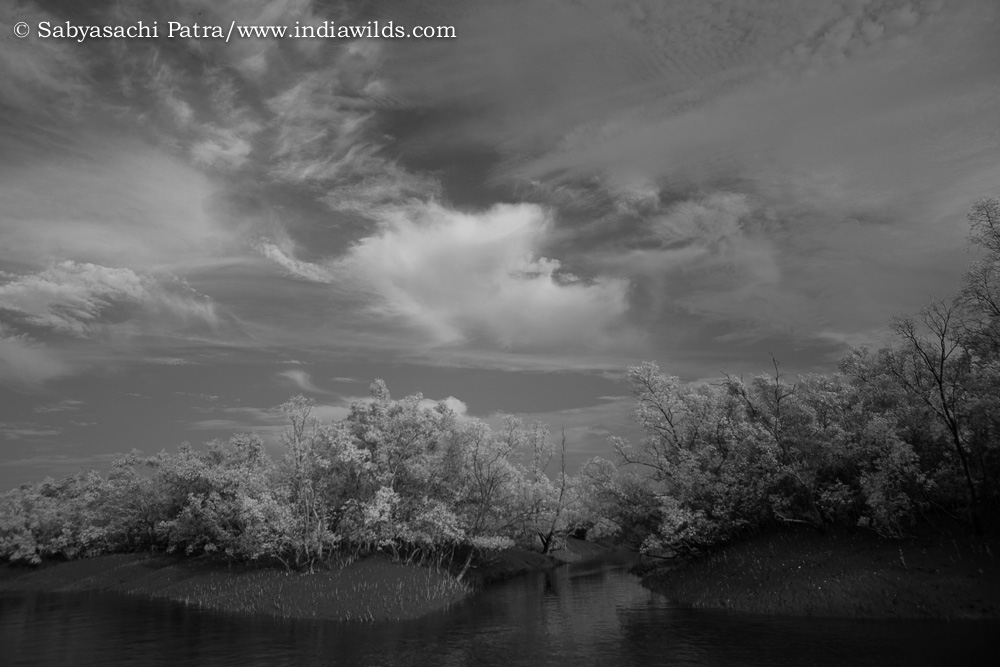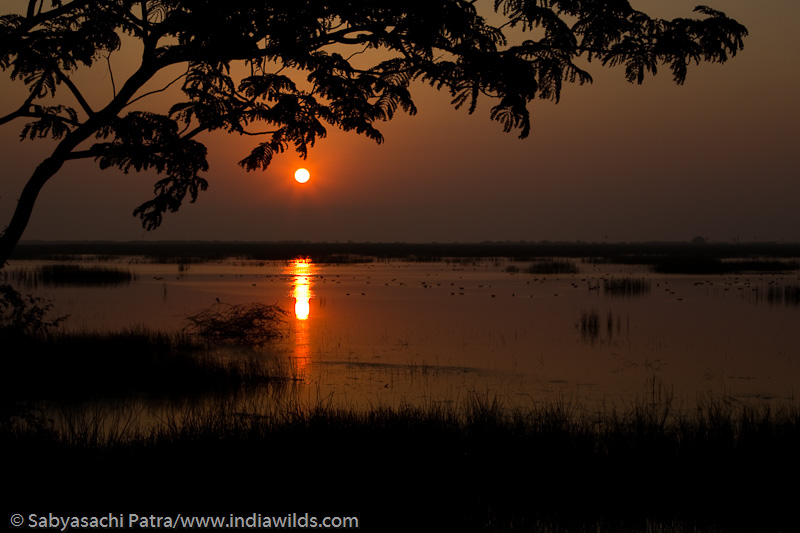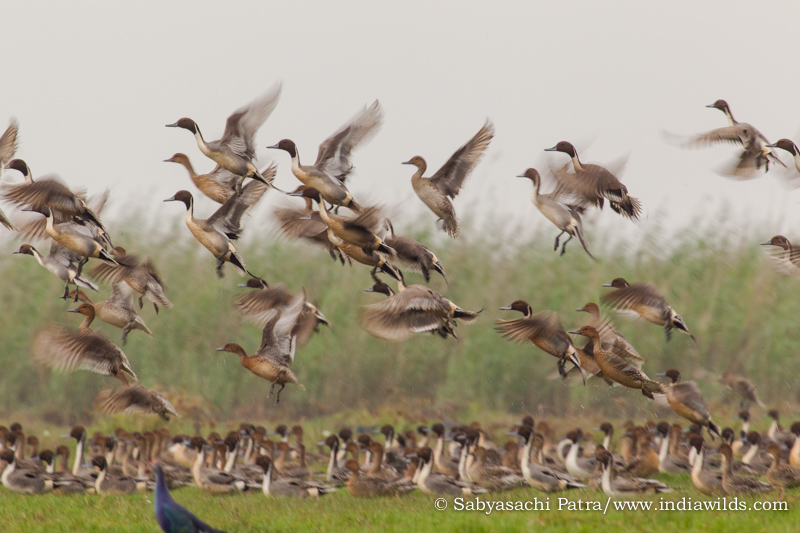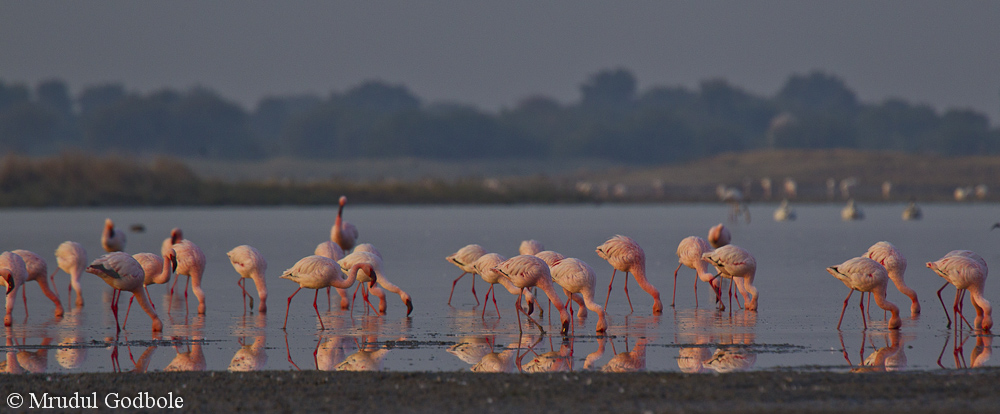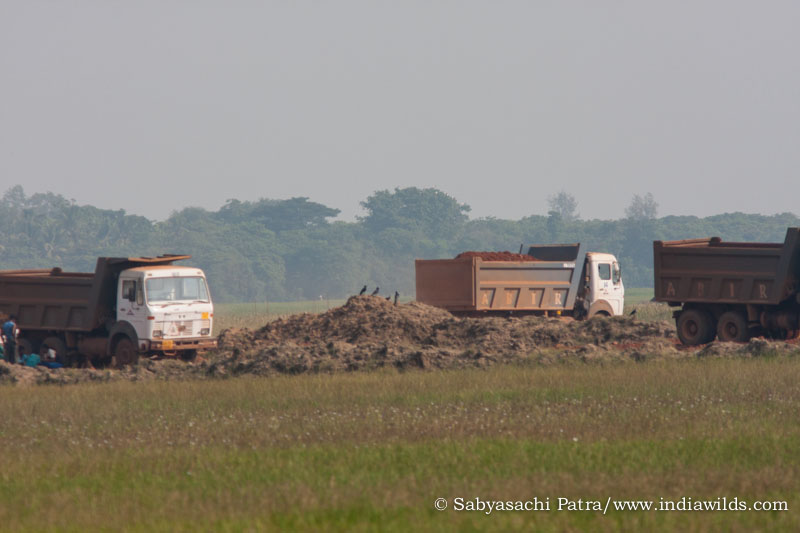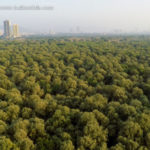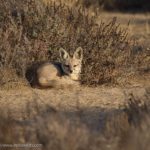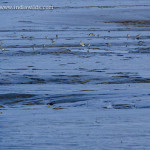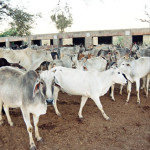Wetlands – An Eternal Abode for Avifauna
by Dr. Hiren B. Soni
Wetlands: An Introductory Approach
The term “Wetland” is used for diverse habitats in different climatic zones of the earth, which is indeed difficult to define in simple term. The International Union for Conservation of Nature and Natural Resources (IUCN) defined “Wetlands” broadly for the purpose of the Ramsar convention on ‘Wetlands of International Importance’ as:
“Wetlands are areas of marsh, fen, peatland or water, whether artificial or natural, permanent or temporary, with water that is static or flowing, fresh, brackish or salt, including areas of marine water, the depth of which at low tide does not exceed six meters”.
Wetlands are ecosystems, whose formation and functioning are characterized by water, covering an area of about 7.5 to 7.8 million sq. km. in the world, constituting about 6.4% of the global landmass. In India, about 75,819 sq. km. area is under wetlands. Wetlands are very rich in their biodiversity being the habitat of 15 to 20% of all living organisms on the earth, representing the major taxonomic groups, from unicellular algae through liverworts, mosses, and ferns to woody angiosperms, from protozoa to mammals and many bacteria to fungi. Therefore, these are highly productive, often equally or more productive than the adjacent terrestrial and aquatic ecosystems. Wetlands also influence the global climate; act as sinks of carbon or source of methane. Global budgets of nitrogen are influenced by nitrogen fixation by Blue Green Algae (BGA) and denitrification in sediments. Lakes, ponds, dams, seasonal water bodies, paddy fields, streams, marshlands, coastlines, mangroves, coral reefs, estuaries, and large stretches of mudflats etc. contribute significantly to make this land beautiful. They also enrich habitat diversity, which results into rich wetland biota, including a colourful bird life.
Characteristics of Wetlands
Wetlands are the areas:
- with hydrophytes and hydric soils, such as those commonly known as marshes, swamps, and bogs;
- without hydrophytes but with hydric soils – for example, flats where drastic fluctuation in water level, wave action, turbidity, or high concentration of salts may prevent the growth of hydrophytes;
- with hydrophytes but non-hydric soils, such as margins of impoundments or excavations, where hydrophytes have become established but hydric soils have not yet developed;
- without soils but with hydrophytes, such as sea-weeds covered portion of rocky shores; and
- without soils and hydrophytes, such as gravel beaches or rocky shores without vegetation.
Prime Importance of Wetlands as Enduring Habitats
Now-a-days, the wetland conservation has been a particular focus, and many of the natural wetlands are used extensively by waterfowls. Wetlands are the most important conservation sites as they support the extensive food chain and rich biodiversity. Biologically, they are the most productive aquatic ecosystem in the world and various globally threatened avian species depend on them. Diverse wetland complexes are of great value in providing habitat for wetland bird species. The significance of wetlands is of paramount importance to biodiversity conservation and sustainability of ecosystem, which is economically important to local populace. Their conservation is an important issue and should be fiercely pursued by the State as well as the Central governments. Wetlands are of immense socio-economic and ecological importance to humankind for the survival of natural biodiversity, and recognized as sources, sinks, and transformers of chemical and biological matters.
Wetlands: An Indian Perspective
By virtue of the geographical position, varied terrains, and climatic zones, India supports a rich diversity of inland as well coastal wetlands. Wetlands are spread all over the country from the cold arid Trans-Himalayan zone to wet Terai regions of Himalayan foothills, from Gangetic plains upto the floodplains of River Brahmputra, from the swamps of north-eastern India to the saline expanses of Gujarat and Rajasthan in north-west and western India. Along the east and west coasts, they occur in the deltaic regions, in the southern peninsula’s wet humid zones, and beyond the Andaman-Nicobar and Lakshadweep Islands.
India is a party in the Ramsar convention of wetlands of international importance with reference to waterfowl habitat. The ratification of this convention puts India under an international obligation to protect the important wetland sites. Besides, the Convention on Biological Diversity puts India under an international obligation to bring about the requisite law reform for the conservation of biodiversity including those in wetlands.
The importance of wetlands was initially highlighted during the Ramsar convention in 1971 at Iran. In total, 118 countries have become the contracting parties to the convention and designated 1,014 wetlands covering a total area of 72 million hectare to the Ramsar list. India joined the convention in October 1981 and designated the first two Ramsar sites of the country viz. Lake Chilka (Orissa) and Keoladeo National Park (Rajasthan). Later, four wetlands – Sambhar Lake (Rajasthan), Loktak Lake (Manipur), Harike Lake (Punjab) and Wullar Lake (Jammu and Kashmir) were also added to the Ramsar list on March 23, 1990.
Holistic Scenario of Wetlands (Gujarat State)
Gujarat is rich in wetland resources, which harbours lakes, salt marshes, creeks, mudflats, estuaries, swamps, mangrove swamps, and man-made (artificially constructed) wetlands. The State supports 79 major wetlands, covers nearly 5 lakh ha area. The wealth of these wetlands is flourished by 27,175 sq. km., constitutes about 35.8% of the total geographical area of India’s wetlands. Region-wise distribution of wetlands including their areas is given below:
Area (in sq. km.) of Wetlands in Gujarat
| Wetland Type | India | Gujarat |
Inland wetland |
35,589 | 2,092 (5.9%) |
| Coastal wetland | 40,230 | 25,083 (62.3%) |
Total |
75,819 | 27,175 (35.8%) |
Source: Indian Space Research Organization (ISRO)
Types of Wetlands in Gujarat
| Inland Wetlands | Area
(sq. km.) |
Coastal Wetlands | Area
(sq. km.) |
| Natural lake | 154 | Mangroves | 1031 |
| Water-logged areas | 289 | Coral reefs | 130 |
| Reservoirs | 1,394 | Mudflats | 21,954 |
| Tanks/Ponds | 198 | Salt-pans | 460 |
| Others including marshland | 57 | Others | 1,512 |
| Total | 2,092 | Total | 25,087 |
Source: Space Application Center (SAC)
Number of Wetlands in different regions of Gujarat
| Region | No. of wetlands* | Area (in sq. km) |
| North Gujarat | 159 | 1107 |
| Kutch | 258 | 21772 |
| Saurashtra | 352 | 2598 |
| South Gujarat | 62 | 1698 |
| Total | 831 | 27175 |
*Wetlands smaller than 56 ha are not included
Out of 831 wetlands in the State, 438 are coastal and 393 are inland wetlands (including 231 small and big reservoirs), covering 92.3% and 7.7% of the total wetland area, respectively. Gujarat has recognized the geo-morphological, floral and faunal values of these important wetlands, which constitutes seven sanctuaries to preserve a total area of 13,052 sq. km. Four major, 5 medium, 25 minor and 5 desert rivers annually add 71,000 million cubic meters of water to the sea around the State. Thus, it would not be an exaggeration to state that Gujarat is pretty well placed among all the States as far as the wetlands in India are concerned. Some of the important and well-known wetlands of the State are – the Great Rann of Kachchh (GRK), the Little Rann of Kachchh (LRK), the Gulf of Kachchh, the Gulf of Khambhat, Nal Sarovar Bird Sanctuary, Khijadia Bird Sanctuary, Porbandar Bird Sanctuary, Thol Bird Sanctuary, and Pariyej and Kanewal Reservoirs. Apart from these, there are numerous unprotected marshes, village-ponds, countryside ponds, irrigation reservoirs, lakes, paddy fields, canals, and rivers in the State, which have been performing various ecological and hydrological functions.
The Gulf of Kachchh, the Gulf of Khambhat, the Great Rann of Kachchh and the Little Rann of Kachchh cover a vast area of coastal wetlands of Gujarat, making this part of the land incomparable to the rest of the country. Total population of wintering waterfowls in these areas has not been estimated, but it is expected to be in the range of millions. Sometimes, just a little less than a million flamingos nest in the Great Rann of Kachchh during their breeding season. Dr. Salim Ali recorded half a million Greater flamingos in a nesting colony in the well-known Flamingo City (Ang Bet) in the Great Rann of Kachchh in 1945. About 70,000 Lesser flamingos were documented in a nesting colony in the Little Rann of Kachchh during August 1998. Nal Sarovar Bird Sanctuary alone supports a population of one to two hundred thousand aquatic birds during peak winter months. Over 40,000 water birds are observed at Thol Bird Sanctuary in a day during peak winter period. Kachchh, a known district for wetlands, has numerous seasonal water bodies. Sample surveys and monitoring of these typical wetlands indicate that millions of water birds find a suitable home in this area. The wetlands in the Little Rann of Kachchh support 82,000 water birds during the winter of 1998, proving beyond doubt that a large number of water birds visit this area every year. There are hundreds of such wetlands in Saurashtra peninsula too.
Waterfowl concentration in Gujarat during winter is one of the highest in the country, as the area falls on the migratory route of the birds. Migratory birds from Europe and Asia continents migrate to the Indian peninsula, passing through the western part of the country, and enjoy the varied habitats. Many of them stay in Gujarat for the entire winter season, while some of them move to the Deccan plateau southwards. Again, during the reverse migration in the months of March and April, some of the migratory birds halt temporarily at these wetlands before their departure from the State and the Country to their breeding grounds.
Due to human greed, these wetlands experience a gradual loss in terms of shrinking of their geographical and hydro-biological regimes, and depletion of biotic resources available therein due to various man-made factors. In Gujarat, wetlands are threatened by many human activities such as draining and/or filling with solid urban and construction wastes (reclamation). Majority of these wetlands have been converted into fishponds and paddy fields. Over-exploitation of wetland resources by harvesting, fishing and hunting causes decline of many floral and faunal elements. Grazing by domestic and wild animals is common and most wetlands are adapted to it, but over-grazing or total ban on grazing may affect wetlands adversely.
Wetlands as Bird Habitats
One of the best known functions of wetlands is to provide a habitat for birds. Humans have known of the link between birds and wetlands for thousands of years. Prehistoric people drew pictures of birds and wetlands on cave walls, scratched them onto rocks, and used them in the design of artifacts; and native folklores provide accounts of bird hunts in wetlands. Wetlands are important bird habitats, and birds use them for breeding, nesting, and rearing young. Birds also use wetlands as a source of drinking water and for feeding, resting, shelter, and social interactions. Some waterfowl, such as Grebes, have adapted to wetlands to such an extent that their survival as individual species depends on the availability of certain types of wetlands within their geographic range. Other species, such as Northern pintail or Eurasian widgeon, use wetlands only during some parts of their lives.
Significant Factors for Survival of Wetland Birds
The relation between wetlands and birds is shaped by many factors. These include the availability, depth, and quality of water; the availability of food and shelter; and the presence or absence of predators. Birds that use wetlands for breeding depend on the physical and biological attributes of the wetland. Birds have daily and seasonal dependencies on wetlands for food and other life-support systems.
The value of a wetland to a specific bird species is affected by the presence of surface water or moist soils and the duration and timing of flooding. Water might be present during the entire year, during only one or more seasons, during tidal inundation, or only temporarily during and after rainfall or snowmelt. At times water might not be present at the land surface, but might be close enough to the land surface to maintain the vegetation and foods that are needed by birds. Birds may use wetlands located in depressions in an otherwise dry landscape, along streams, or in tidally influenced areas near shorelines.
The availability or influence of water is a very important wetland feature to birds. It is not, however, the only feature that determines if birds will be present, how birds use the wetland, or how many kinds or numbers of birds may use the wetland. Other determining physical or biological factors include water depth and temperature, presence or absence of vegetation, patchiness, or openness of vegetation, type of vegetation, foods, water chemistry, type of soils, and geographic or topographic location. Any variations in any of these wetland features will cause subtle, but distinct, differences in bird use.
Wetlands provide food for birds in the form of plants, vertebrates, and invertebrates. Some feeders forage for food in the wetland soils, some find food in the water column, and some feed on the vertebrates and invertebrates that live on submersed and emergent plants. Birds eat the fruits, tubers, and leaves of wetland plants. Water temperatures influence food production. Invertebrate production in the water column may ultimately depend on water temperature and the ability of a wetland to produce algae. Cold water might not be a hospitable environment for small animals and plants that some wetland birds eat. However, water that is too warm also might not produce foods that some birds prefer.
Wetland vegetation provides shelter from predators and from the weather. The presence or absence of shelter may influence whether birds will inhabit a wetland or a nearby upland area. Predators are likely to abound where birds concentrate, breed, or raise their young. Wetlands form an important buffer or barrier to land-based predators and reduce the risk of predation to nesting or young birds. However, some predators, such as the rats and/or gerbils, are well adapted to both wetland and upland environments, and take large numbers of both young and nesting birds. Animals like Jungle cats, Mongoose, and Civet cats forage for nesting or sleeping birds along the edges and interiors of wetlands. Other animals, such as the Indian Flap-shell turtle, Crocodiles, Gharials and Monitor lizards are effective water-based predators of young birds, particularly young waterfowl. Snakes take their toll as well. Many bird species that are highly adapted to feeding in a wetland environment also have genetic adaptations that lower their risk of becoming prey. One such example is Bittern, which has excellent protective coloration. The same vegetation that hides birds from predators also provides some shelter from severe weather.
The geographic location of a wetland may determine how and when birds will use it or use adjacent habitat. In the northern latitudes or at high altitudes, some wetlands are covered with ice in the winter and are temporarily “out of service” for birds adapted to a water environment, but emergent vegetation might still offer shelter and food for some species. Birds that eat fish, aquatic invertebrates, or submersed vegetation cannot forage for food because of the ice cover. Some wetlands are on the migration path of waterfowl and other migratory birds and provide stopover locations for traveling birds. These birds might feed in agricultural fields during the day and return to the shelter of wetlands during the night.
The “perennial water bodies” of India as well as Gujarat are one of the special types of wetlands, important for migrating waterfowl. Here the timing and duration of inundation and the salinity of the water are important factors in the production of plants and invertebrates used by birds. Wetland characteristics are influenced by number of things such as:
- Water-level fluctuations throughout the year, in response to rainfall and snowmelt, that maintain wetland zones such as wet meadows and marshes
- Short-term (years) and long-term (decades) climatic trends that cycle wetlands between a wet and dry state
- Interaction of surface and ground water
- Interaction of ground water with rocks and soils that influence salinity and other wetland water chemistry
Importance of Wetlands for Birds’ Population
Because of the great variety of wetlands, bird adaptation and use of wetland environments differs greatly from species to species. Birds’ use of wetlands during breeding cycles ranges widely. Some birds depend on wetlands almost totally for breeding, nesting, feeding, or shelter during their breeding cycles. Birds that need functional access to a wetland or wetland products during their life cycle, especially during the breeding season, can be called “wetland dependent”. Other birds use wetlands only for some of their needs, or they might use both wetland and upland habitats.
Some bird species use forested wetlands as well as forested uplands, feeding on the abundant insects associated with trees. These birds are not dependent on wetlands because they use both habitats equally well. Some birds, such as Tree ducks, are found primarily in forested wetlands and are dependent on this wetland type.
Many migratory birds are wetland dependent, using wetlands during their migration and breeding seasons. Migratory birds may spend the entire winter in wetlands of India as well Gujarat, may be farther south. Throughout winter, these birds use wetlands for food and nutrients to sustain them for their return trip and the breeding season.

A migratory greater spotted eagle Aquila clanga on reeds in its wintering habitat at Hessarghatta in India
Influence of Wetlands on Waterfowl Population
Considerable research has increased the understanding of wetlands’ influence on the numbers of waterfowl that breed and their breeding success. However, the relation between wetlands and the population and propagation of various waterfowl species is not well understood. This relation depends on:
(1) Number of wetlands in the area
(2) Wetlands’ size and water depth
(3) Whether the wetlands hold open water during pre-winter periods
(4) Climate and
(5) Species of bird and the bird’s adaptations to wetlands
Different waterfowl species adapt to different wetland types, inhabit different geographic areas, and nest at different times. The relation of many other species of birds to wetlands is undoubtedly just as complex.
Wetland Loss and Decline of Bird Diversity
For most wetland-dependent birds, habitat loss in breeding areas translates directly into population losses. As wetlands are destroyed, some birds may move to other less suitable habitats, but reproduction tends to be lower and mortality tends to be higher. Hence, the birds that breed in these poorer quality habitats will not contribute to a sustainable population through the years.
Wetland loss due to draining, filling, or altering of surface-water and ground water flow is a concern to many people. Wetland degradation also has a substantial effect on birds. Although wetland degradation is a serious problem, it is one that is more subtle and less understood than wetland losses. Degradation can take many forms:
- Amounts and periodicity of water supplies can be altered
- The quality of water flowing into and through a wetland can be modified
- The flows of sediments or freshwater to coastal marshes can be reduced
- Water levels can be stabilized in wetlands that otherwise would undergo beneficial draw-downs or water-table fluctuations
- Wetland vegetation may be altered by harvesting or by introducing exotic species, making it of little or no value to wetland-dependent birds
An example of wetland degradation is well-observed in some wetlands of India (Keoladeo Ghana National Park, Bharatpur, Rajasthan) and Gujarat (Nal Sarovar Bird Sanctuary). Nutrients and sediments entering the bay from agricultural, urban, and industrial areas have caused increased algal blooms, decreased invertebrate production, and lowered oxygen levels. This degradation has reduced the acreage of grasses and reed-beds that form an important link in the food chain for invertebrates, fish, and wetland-dependent birds. The decline in Duck population in this area is thought to be directly related to the decline in reeds.
Chemicals and sediments that move from agricultural areas into wetlands are two of the most pervasive sources of degradation. The shift in human populations from inland areas to coastal areas of West coast of Gujarat has caused problems in coastal wetlands through overloaded sewage treatment systems. The large and growing volume of industrial wastes that enter ground- and surface-water supplies also threatens to degrade wetlands. These threats, combined with habitat destruction, have a net negative effect on the population of wetland birds. Thus, if the amount and quality of wetland habitat is substantially reduced, populations of wetland-dependent birds in the area also can be expected to decrease.
Threats to Avian Habitats
Over 90% of the wetlands have been lost during the past 150 years, accentuated by human actions on a worldwide basis, with a higher fragmentation and loss of areas, which negatively affects the water bird population. Presently, almost 50% of the world’s wetlands are on the verge of disappearing from the geographic regimes due to agricultural expansion and urban development and various anthropogenic threats such as industrialization, urbanization, drainage for agriculture and water system regulation. Concurrent agricultural conversion of wetlands causes unavailability of native aquatic seeds consumed by waterfowls. Both natural and anthropogenic factors have resulted into siltation, changes in salinity concentration, excessive and redundant growth of freshwater weeds, decrease in fish productivity, changes in species composition of avifauna, eutrophication, and excessive extraction of bioresources and overall loss of aquatic biodiversity.
Major threats faced by the wetlands are removal of vegetation layer by local dependants in the catchment area of that particular lake, consequent soil erosion, excessive use of water for irrigation for agricultural practices, hunting and poaching of waterfowls, encroachment for human settlements, overexploitation of fish, timber, medicinal plants, water transport, and water supply, reclamation for urban and industrial development, pollution from industries, domestic and agricultural areas, conversion to aquaculture or fish ponds or culture ponds, diversion of water for farming, and hydro-electricity generation, etc. It has been estimated that nearly 1 hectare of the world’s wetland area is getting degraded every minute.
Wetlands are increasingly threatened due to various anthropogenic activities. ‘Ramsar Convention’ promotes the concept of ‘wise use’, which refers to the ‘sustainable utilization’ for the benefit of humankind in a way compatible with the maintenance of the natural properties of the ecosystem. Wetlands have been managed for long duration by the local communities, which depend on them for many of their needs. Therefore, management requires a critical assessment of functional values of the wetland, together with an understanding of traditional management practices and active participation of stakeholders and local communities.
Conservation and Management Framework for Sustainability of Water Birds
Several international treaties are partly responsible for much of the formal wetland protection in this country–the Migratory Bird Treaty (MBT) and the Convention on Wetlands of International Importance (CWII) especially as Waterfowl Habitat.
However, many people believe that ownership or management of wetlands by public conservation agencies, such as MoEF (Ministry of Environment and Forests), MoES (Ministry of Environmental Science), NWC (National Wetland Committee), NWLB (National Wildlife Board), and by private organizations, such as WCS (Wetland Conservation Society) and Regional Wetland Councils (RWC), offers the best assurance that the highest value wetlands will be maintained for future generations.
- Biodiversity Conservation by Local Communities of Kutch, Gujarat, India - 22 March,2019
- Wetlands – An Eternal Abode for Avifauna - 20 April,2017
- In Search Of Stoliczka’s Bushchat - 28 March,2016

